历史
19th century
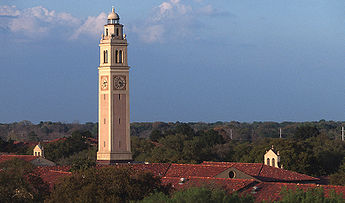
Memorial Tower is a campanile in the heart of LSU's campus.
Louisiana State University Agricultural & Mechanical College had its origin in several land grants made by the United States government in 1806, 1811, and 1827 for use as a seminary of learning. It was founded as a military academy and is still today steeped in military tradition, giving rise to the school's nickname "The Ole War Skule." In 1853, the Louisiana General Assembly established the Seminary of Learning of the State of Louisiana near Pineville, Louisiana. The institution opened January 2, 1860, with Colonel William Tecumseh Sherman as superintendent. A year later, Sherman resigned his position after Louisiana became the sixth state to secede from the Union, on January 26, 1861. The school was forced to close on June 30, 1861, with the start of the American Civil War. During the course of the war, the University reopened briefly in April 1863, but was closed once again with the invasion of the Red River Valley by the Union Army. The losses sustained by the institution during the Union occupation were heavy, and after 1863 the seminary remained closed for the remainder of the Civil War. Following the surrender of the Confederates at Appomattox Court House on April 9, 1865, General Sherman donated two cannons to the institution. These cannons had been captured from Confederate forces after the close of the war and had been used during the initial firing upon Fort Sumter in April 1861. The cannons are still displayed in front of LSU's Military Science building.
The seminary officially reopened its doors on October 2, 1865, only to be burned October 15, 1869. On November 1, 1869, the institution resumed its exercises in Baton Rouge, where it has since remained. In 1870, the name of the institution was officially changed to Louisiana State University.
Louisiana State University Agricultural & Mechanical College was established by an act of the legislature, approved April 7, 1874, to carry out the United States Morrill Act of 1862, granting lands for this purpose. It temporarily opened in New Orleans, June 1, 1874, where it remained until it merged with Louisiana State University in 1877. This prompted the final name change for the University to the Louisiana State University and Agricultural & Mechanical College.
20th century
On April 30, 1926, formal dedication of the present LSU campus took place, following the school's history at the federal garrison grounds (now the site of the state capitol) where it had been located since 1886. Prior to this, LSU utilized the quarters of the Institute for the Deaf, Mute, and Blind. Land for the present campus was purchased in 1918, construction started in 1922, and the move began in 1925; however, it was not until 1932 that the move was finally completed. After some years of enrollment fluctuation, student numbers began a steady increase, new programs were added, curricula and faculty expanded, and a true state university emerged.
In 1928, LSU was a small-time country school that generated little interest or attention in the state. Labeled a “third-rate” institution by the Association of State Universities, the school had only 1800 students, 168 faculty members, and an annual operating budget of $800,000. In 1930, Huey Long, the governor of Louisiana, initiated a massive building program on campus to expand the physical plant and add departments.
By 1936, LSU had the finest facilities in the South, a top-notch faculty of 394 professors, a new medical school, more than 6,000 students, and a winning football team. In only eight years, it had risen in size from 88th in the nation to 20th, and it was the 11th largest state university in the nation. Long financed these improvements by arranging for the state to purchase acreage from the old LSU campus, which adjoined the grounds of the new State Capitol building in downtown Baton Rouge. To the consternation of his critics, Long essentially diverted $9 million for LSU’s expansion and increased the annual operating budget to $2.8 million.
LSU was hit by scandal in 1939 when James Monroe Smith, appointed by Huey Long as president of LSU, was charged with embezzling a half-million dollars. In the ensuing investigation, at least twenty state officials were indicted. Two committed suicide as the scandal enveloped Governor Richard W. Leche, who received a 10-year federal prison sentence as a result of a kickback scheme. Paul M. Hebert, Dean of LSU's law school at the time, then assumed interim presidency in Smith's place.
Although some African-Americans students tried to enroll in LSU in 1946, the university did not admit African-Americans until the 1950s. In 1953 A. P. Tureaud, Jr. enrolled under court order, but his enrollment was cancelled when a higher court overturned the ruling. His case was ultimately decided by the U.S. Supreme Court. Tureaud returned to LSU in 1956. A classroom building on the LSU campus is named for his father, the late A. P. Tureaud, Sr., a noted Civil Rights leader. The federal courts mandated full integration for LSU in 1964. The first African-American graduate of the LSU Law School was former New Orleans mayor, the late Ernest N. "Dutch" Morial.
In 1969, mandatory ROTC for freshmen and sophomores was abolished; however, LSU continues to maintain Air Force and Army ROTC. In 1978, LSU was named a sea-grant college, the 13th university in the nation to be so designated. In 1992, the LSU Board of Supervisors approved the creation of the LSU Honors College.
21st century
In the aftermath of Hurricane Katrina, LSU accepted an additional 2,300 displaced students from the greater New Orleans area, such as Tulane University, Loyola University New Orleans, Xavier University of Louisiana, and University of New Orleans. In addition to accepting displaced students, university officials also took on the challenge of housing and managing many hurricane victims, converting the Pete Maravich Assembly Center into a fully-functional field hospital. Around 3,000 LSU students volunteered during the months after Katrina, assisting with the administration of medical treatment to some 5,000 evacuees and screening another 45,000 for various diseases.
In 2007, long-time LSU System president William Jenkins announced his retirement, and John V. Lombardi was named his replacement. He was previously the president of the University of Massachusetts at Amherst and LSU rival University of Florida. The current chancellor of LSU, Dr. Michael V. Martin, assumed chancellorship on August 1, 2008. Prior to his appointment as LSU’s eighth chancellor, Dr. Martin had established a distinguished career in higher education, serving most recently as president of New Mexico State University.
校园
历史
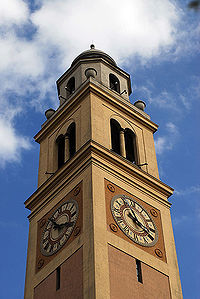
Memorial Tower is in the heart of LSU's campus.
The current LSU campus is located on 2,000 acres (8.1 km²) just south of downtown Baton Rouge. A majority of the university's 250 buildings, most of which were built between 1925 and 1940, occupy a 650-acre (2.6 km²) plateau on the banks of the Mississippi River. Other campuses in the LSU system include the LSU Agricultural Center, Pennington Biomedical Research Center, University of New Orleans, LSU at Shreveport, LSU at Eunice, LSU at Alexandria, and the Louisiana State University Health Sciences Center New Orleans. In addition, LSU owns and operates the J. Bennett Johnston, Sr. Center for Advanced Microstructures and Devices (CAMD), which is a 1.3 GeV synchrotron radiation facility.
The Olmsted Brothers Firm of Brookline, Massachusetts, designed the current campus around 1921 when LSU was planning to move its campus from downtown Baton Rouge. The Olmsted firm originally designed the campus for up to 3,000 students, but state officials asked the firm to scale the plan back due to budgetary constraints; subsequently, the new plan presented to the state by the Olmsted Brothers centered the campus around a cruciform-shaped quadrangle similar to the one that exists on campus today.
For reasons unknown, the Olmsted Brothers firm was dropped from the project, and an architect named Theodore Link, who was well-known for designing Union Station in St. Louis, Missouri, took over the campus master plan. Link collaborated with Wilbur Tyson Trueblood on the project, but remained faithful to the campus that the Olmsted firm had designed. Unfortunately, Link died in 1923 before the plan was completed. New Orleans architects Wogan and Bernard completed Link’s work and the campus was dedicated on April 30, 1926.
The first building actually constructed on the present campus was the Swine Palace, the former livestock barn that is now the Reilly Theater. Most of the current buildings that occupy the universities Quad where completed between 1922 and 1925. Because the original campus was designed to accommodate 1,500 students, space is now at a premium at LSU. During the 1990s, LSU officials created a set of design guidelines that call for all newly constructed buildings to have an Italian Renaissance flavor.
Architecture and landscape
Although the Olmsted firm had originally envisioned a Spanish or Mexican style design for the University, Link designed the campus with tan stucco walls, red-tiled rooftops, and extensive porticoes in an attempt to emulate the architecture of Italian Renaissance architect Andrea Palladio. The design of Hill Memorial Library was loosely based on that of the Boston Public Library, which was the first public library in the U.S. The flanking academic buildings that formed the rest of the Quad represented the major disciplines at the university, and their placement was modeled after that of buildings on the University of Virginia’s campus, which was designed by Thomas Jefferson.
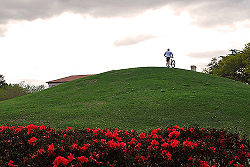
A dismounted bicyclist on the Indian Mounds, which are estimated to be over 5,000 years old.
LSU’s campus is also known for the 1,200 live oak trees that shade the ground of the university. During the 1930’s, landscape artist Steele Burden planted many of LSU’s live oaks and magnolia trees, which are now valued at over $50 million. Many of the azaleas, crepe myrtles, ligustrum, and camellias planted in the quadrangle were added to the campus in the 1970’s. Through the LSU Foundation’s “Endow an Oak” program, individuals and groups are able to endow live oaks across the university's campus. Thomas Gaines, author of The Campus as a Work of Art, praises LSU's landscaping as "a botanical joy" and lists it among the 20 best campuses in the United States.
Fifty-seven buildings on the LSU campus are listed on the National Register of Historic Places, and the campus is protected by the State Capital Historic District Legislation. The LSU Indian Mounds, which are part of a larger mound group spread throughout the state, are located near the northwestern corner of the campus and were built an estimated 5,000 years ago. Originally serving as territorial markers, or possible symbols of group identity, the mounds are older than any other man-made structure in the Americas, and predate the construction of the Great Pyramid of Giza. The mounds were placed on the National Register of Historic Places in 1999.
学术
Colleges and schools
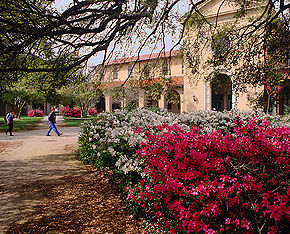
Foster Hall as seen from Troy Middleton Library.
A reorganization plan of LSU's academic units was unveiled by Executive Vice Chancellor and Provost Astrid Merget on April 14, 2009. If approved, it would reshuffle the University's academic units into colleges that the current leadership deems more efficient. Some of the proposed changes include replacing the Colleges of Arts and Sciences, Basic Science, and Art and Design with a College of Humanities and College of Science.
- School of Agriculture
- Art & Design
- Arts & Sciences
- Basic Sciences
- E.J. Ourso College of Business
- School of the Coast and Environment
- Continuing Education
- Education
- Engineering
- Graduate School
|
- Honors College
- Paul M. Hebert Law Center
- Library & Information Science
- Manship School of Mass Communication
- Louisiana State University School of Dentistry
- Music & Dramatic Arts
- School of Social Work
- University College
- Veterinary Medicine
- Louisiana State University School of Medicine
|
Rankings
|
|
University rankings (overall)
|
|
| ARWU World |
201-302 |
| ARWU North & Latin America |
101-134 |
| Forbes |
341 |
| Times Higher Education |
501-600 |
| USNWR National University |
128 |
Louisiana State University is ranked 128th in the national universities category by the 2010 U.S. News & World Report ranking of U.S. colleges (64th among public universities). LSU is also ranked as the 88th best public university in the nation by Forbes magazine and is featured in the 2010 edition of Princeton Review's Best 371 Colleges guide. Additionally, U.S. News & World Report ranked LSU as the 16th most popular university in the nation, placing it ahead of other regional universities such as The University of Texas, The University of Georgia, and The University of Alabama. Programs that have received recognition within LSU include the following:
- The E. J. Ourso College of Business has two professional programs ranked by U.S. News & World Report: in 2008, the Public Affairs Institute ranked 57th nationally and 40th among public universities according to the magazine, and the Flores MBA program was ranked 62nd nationally and 33rd among public universities. Additionally,
- LSU students have won the International Student High Achievement Award, an accolade given to students who score the highest possible score on the Certified Internal Auditor (CIA) exam, seventeen times during the last twenty-one years.
- In 2007, the Flores MBA Program was ranked seventh in the nation "for attracting corporate MBA recruiters who recruit regionally" by the Wall Street Journal.
- The LSU College of Engineering undergraduate program was ranked 85th by U.S. News & World Report while the graduate program was ranked 90th.
- The Paul M. Hebert Law Center is ranked as the 75th best law school in the nation by the 2010 U.S. News Rankings of Best Law Schools.
- In 2009, Entrepreneur Magazine ranked LSU among the top 12 Entrepreneurial Colleges and Universities in the nation.
- The University's Robert S. Reich School of Landscape Architecture was ranked No. 2 nationally in undergraduate and No. 3 in graduate programs by DesignIntelligence in its 2009 edition of "America's Best Architecture & Design Schools". The journal has ranked the school in the top five since 2004.
- The LSU College of Education graduate program was ranked 91st in the nation by U.S. News & World Report.
- The LSU French program, comprising the Department of French Studies and the Center for French and Francophone Studies, is recognized by the Cultural Services office of the French Ambassador to the United States as a centre d’excellence, an honor given to only 15 university French programs in the United States, and is ranked as one of the top 20 undergraduate French programs in the nation.
- The LSU graduate program in fine arts is ranked 76th in the nation by U.S. News & World Report.
- The LSU graduate program in library and information studies is ranked 22nd in the nation by U.S. News & World Report, tied with the programs at San Jose State University, University of Alabama, and University of Oklahoma.
Libraries and museums
Libraries
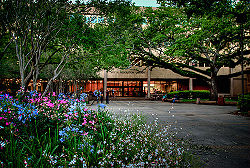
Troy Middleton Library as viewed from the LSU quad.
LSU's main library collection, numbering almost three million volumes, is housed in Troy H. Middleton Library on the main quadrangle of the University. It is both a general use library and a U.S. Regional Depository Library, housing publications from the federal government, United Nations, and United States Patent and Trademark Office. The LSU Libraries belong to the Association of Research Libraries, which includes the top 113 academic libraries in the U.S. and Canada; the Association of Southeastern Research Libraries (ASERL); LYRASIS, which is a merger of theSoutheastern Library Network SOLINET with PALINET; and the Louisiana Academic Library Information Network Consortium (LALINC). LSU was among the founding members of the Louisiana Online University Information System (LOUIS) network which provides access to most academic library catalogs in the state. The LSU Libraries’ subject strengths include Louisiana materials, sugar culture and technology, Southern history, agriculture, petroleum engineering, plant pathology, natural history, and various aspects of aquaculture including crawfish, wetlands research, and marine biology.
LSU Libraries’ U.S. Regional Depository Library and the U.S. Patent Depository Library collections are housed in Middleton Library. The Library has been a depository for federal government publications since 1907 and has a substantial number of U.S. documents issued before and after that time. The Library became a Regional Depository Library in 1964. The Library was designated an official depository for U.S. Patents in 1981. The patent collection includes all patents issued from 1871 to the present.
The LSU Libraries Special Collections in Hill Memorial Library provides a center for research in the humanities, social sciences, and fine arts. The primary strength of Special Collections resides in The Louisiana and Lower Mississippi Valley Collections, an outstanding integrated collection that consists of materials documenting the history and culture of the region. It provides rare and early imprints pertaining to the exploration and colonization of the region; books on Louisiana subjects; books by Louisiana authors; Louisiana state documents; extensive and prestigious manuscript collections, which include the personal papers of important individuals in the history of the region, including the Long family; records of business, professions, and organizations; and extensive photographic collections.
Museums
The LSU campus houses eight museums that feature original works by students as well as traveling exhibits by local, national, and international artisans. In addition to the campus museums, LSU currently runs four museums in the greater Baton Rouge area: The LSU Museum of Art, The LSU Museum of Natural History, The LSU Museum of Natural Science, and the LSU Rural Life Museum.
The LSU Museum of Art (LSU MOA), located in the Shaw Center for the Arts in downtown Baton Rouge, opened in March 2005. The museum manifests a decade-long vision to offer LSU and the Baton Rouge community greater access to its diverse art collection, changing exhibitions, education programs, and special events. The LSU MOA shares the Shaw Center for the Arts with many cultural partners including the LSU School of Art Gallery, LSU's Laboratory for Creative Arts and Technology, the Manship Theatre, and the Community School for the Arts of the Arts Council of Greater Baton Rouge.
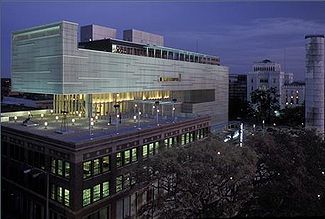
The Shaw Center for the Arts, which houses the LSU MOA.
LSU MOA first opened in 1962 under the name of The Anglo-American Art Museum in the Memorial Tower on LSU's Baton Rouge campus. The museum and its collection were established through a generous gift to LSU in 1959 from an anonymous donor who wished to support an institution that would illustrate British and continental influences on early American art and culture in the South. The museum's significant collection of American and British portraiture, furniture, and decorative arts grew from this foundation.
The LSU Museum of Natural Science was founded in 1936, when its first director, George H. Lowery, Jr., assembled a few study specimens of birds in a classroom in Audubon Hall. Since its move to Murphy J. Foster Hall in 1950, the museum has continued to expand and is currently one of the nation's largest natural history museums, with holdings of over 2.5 million specimens. As the only comprehensive research museum in the south-central United States, the LSU Museum of Natural Science fulfills a variety of scientific and educational roles at the university, including: the generation of new knowledge in the fields of zoology, archaeology, and paleontology through scholarly research based primarily on natural history collections; collection and preservation of research specimens as a resource for study of the Earth's natural history; education of graduate and undergraduate students in academic areas that are most effectively taught in the museum setting; education of the public by means of exhibits and lecture programs; and assistance to local citizens, wildlife officials, and forensic specialists through identification and consultation services.
The LSU Rural Life Museum has been listed as one of the top outdoor museums in the country. The variety of people who settled in Louisiana made significant and lasting contributions to the state’s unique culture and heritage. It is one of the few museums that celebrates the day-to-day lives of early Americans, including Native Americans, French and Spanish settlers, Anglo-Americans, Germans, Africans, and Acadians. The Rural Life Museum features several displays and exhibits on the pre-industrial residents of Louisiana.
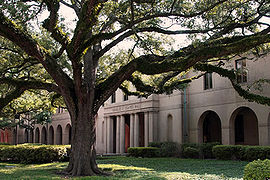
A live oak in front of Coates Hall.
The permanent collection includes tools, utensils, furniture, and farming equipment. The recreated “working plantation” consists of a complex of buildings authentically furnished to reconstruct all the major activities of life on a typical 19th century plantation. The museum also serves as a research facility for LSU students engaged in heritage conservation studies.
In 1999, the sixteen natural history collections at Louisiana State University in Baton Rouge were designated by the state legislature as the Louisiana Museum of Natural History. Together, these collections hold a total of more than 2.8 million specimens, objects, and artifacts that document the rich natural history of Louisiana. These collections are dispersed among six independently administered units on campus, and include the Vascular Plant Herbarium, the Mycological Herbarium, the Lichen Herbarium, the Louisiana State Arthropod Museum, the Palynology Collection, the Mineralogy and Petrology Collections, the Textile and Costume Museum, the Louisiana Geological Survey Log Library and Core Repository, and, within the LSU Museum of Natural Science, the Collection of Amphibians and Reptiles, the Collection of Birds, the Collection of Fishes, the Collection of Genetic Resources, the Collection of Mammals, the Vertebrate Paleontology Collection, the Collection of Microfossils and Invertebrates, and the Anthropological and Ethnological Collections.
Student life
Organizations
There are over 350 student organizations currently active at LSU, including a student government and a total of 38 fraternities and sororities. LSU Student Government, sometimes referred to as LSU SG, is the official student government association of Louisiana State University and Agricultural and Mechanical College. It is the voice of the LSU student body on matters ranging from university administration to parking and transportation. In addition to the roles of advising and advocating, SG controls approximately $5.5 million of student and state funding each year to support student initiatives such as the LSU Student Technology Fee, student organization support through PSIF, ORF, and other funding programs, the Coca-Cola fund for new initiatives, and the SG Newspaper Initiative that provides free copies of The Advocate, Wall Street Journal, and The New York Times.
Much like the United States Government, LSU Student Government is divided into three major branches; Executive, Legislative, and Judicial. LSU SG is headed by the Student Body President and the Student Body Vice President, elected to office during the spring semester of each academic year. A College Council system is also established to designate members of SG to the duties of representing specific academic colleges. Additionally, a Student Union Board representative is elected each spring to represent student interests and oversee programs and regulations of the LSU Student Union.
Media
The Daily Reveille, LSU's student newspaper, has been keeping students informed for more than a century. It publishes five days a week during the fall and spring semesters and twice a week during the summer semester. The paper has a circulation of 11,000 or more. The Daily Reveille, which is funded by advertising and student fees, employs more than 80 students each semester in jobs ranging from writing and editing to design and illustration. The Daily Reveille was recognized for its outstanding coverage in the 2002-2003 school year with a Pacemaker Award from the Associated Collegiate Press and the Newspaper Association of America Foundation, the highest award granted to student publications in the United States. Princeton Review named The Daily Reveille as the 12th best college newspaper in the nation in its 2008 edition of The Best 361 Colleges.The Daily Reveille won the Editor & Publisher award, or EPpy, in 2008 for best college newspaper Web site.
KLSU is an FCC-licensed NCE (non-commercial educational) radio station, broadcasting with 5,000 watts of power at 91.1 on the FM dial. Radio on the LSU campus began in 1915 when Dr. David Guthrie, a physics professor, patched together a radio transmitter from spare parts. Call letters KFGC were assigned in the early 1920s. In 1924 the station covered the first football game played in Tiger Stadium and thus provided the first broadcast of a football game in the South. In the 1950s, it switched to FM and became the first educational station in the country to broadcast a college opera. And in the 1990s, it was the first college station to stream audio on the Net. The station is on the air 24 hours a day, 7 days a week, with a format of college alternative music and specialty programming. All programming and operations are managed by the student staff.
Broadcasting on campus cable channel 75, Tiger TV reaches approximately 6500 students who live and congregate in common areas on campus, such as residence halls and sorority and fraternity houses. It employs approximately 50 people each semester giving students the opportunity to be station manager, camera operators, news reporters, programmers, on-air personality, even work with clients to help create TV commercials. In its short on-air history, Tiger TV has grown to include an almost $1-million state of the art television studio and provide more than 8 hours of original programming each day. The station mixes news and sports programming with local and national entertainment shows, and recently added first-run movies. Tiger TV shares its production equipment and facilities with the Manship School of Mass Communication and is one of the most modern student television studios in the country.
Greek life
The Greek community at Louisiana State University is composed of 38 organizations, governed by three councils. These groups work together with University, local, and national affiliates to help achieve the goals and ideals their organizations were founded upon. In the 2006-2007 academic year, Greek organizations at LSU contributed over 50,000 hours and $250,000 to community and philanthropic efforts. Students in the LSU Greek community are also active in many areas on campus, outside of their fraternity or sorority. Greek students are active in over 80 student organizations, including Student Government and various honor societies. In celebration of Greek Week during 2008, the LSU Greek community raised over $117,000 and built two houses for Habitat for Humanity.
| Fraternities |
National Pan-Hellenic Council |
Pan-Hellenic Council |
- Acacia
- Alpha Gamma Rho
- Delta Chi
- Delta Kappa Epsilon
- Kappa Alpha Order
- Kappa Sigma
|
- Lambda Chi Alpha
- Phi Delta Theta
- Phi Kappa Psi
- Pi Kappa Alpha
- Pi Kappa Phi
- Sigma Alpha Epsilon
|
- Sigma Alpha Mu
- Sigma Chi
- Sigma Nu
- Sigma Phi Epsilon
- Tau Kappa Epsilon
- Theta Xi
|
- Alpha Kappa Alpha
- Alpha Phi Alpha
- Delta Sigma Theta
- Kappa Alpha Psi
- Omega Psi Phi
|
- Phi Beta Sigma
- Sigma Gamma Rho
- Zeta Phi Beta
- Iota Phi Theta
|
- Chi Omega
- Delta Delta Delta
- Delta Gamma
- Delta Zeta
- Kappa Alpha Theta
- Kappa Delta
|
- Kappa Kappa Gamma
- Phi Mu
- Pi Beta Phi
- Sigma Alpha
- Zeta Tau Alpha
|
Flagship agenda
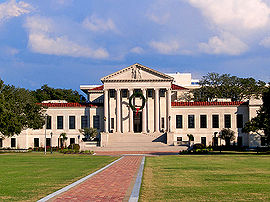
The Paul M. Hebert Law Center, which houses the LSU law school.
In 2003 Chancellor Mark Emmert spearheaded the creation of the Flagship Agenda, a plan to reverse the low morale, lack of competitiveness, and lack of available resources that had plagued LSU during the early 1990s. Its focus is to have LSU better serve Louisiana and the world by increasing student quality and research productivity, thereby vaulting LSU into placement as one of the finest public universities in the country. Because the improvements put a higher financial strain on students, the agenda has had some controversy. However, many people involved with the university agree that the agenda's implementation has been successful. Sean O' Keefe, who in 2005 left his post as head of NASA to become LSU's new chancellor, pledged to continue the agenda until its conclusion in 2010, which will coincide with LSU's 150th anniversary. On 2008 January 16 O'Keefe resigned effective 2008 June 1. Recent cuts to Louisiana's higher education budget threaten to reverse the gains of the Flagship Agenda.
- Flagship agenda action plan
- Increase research productivity by hiring a significant number of new, high-quality faculty and improving technology infrastructure.
- Increase number and quality of graduate students and programs through targeted investments and program review.
- Increase quality of undergraduate students and programs by raising admissions standards, improving recruitment, and reviewing courses of study.
- Increase quality of campus life by increasing diversity, inclusiveness, and facilities investments.
- Assess LSU’s progress and communicate achievements.
- Increase funding to support the previous actions through more state and private support.
Publications
- LSU Press is a nonprofit book publisher dedicated to the publication of scholarly, general interest, and regional books. It publishes approximately 80 titles per year and continues to garner national and international accolades, including four Pulitzer Prizes. John Kennedy Toole's A Confederacy of Dunces is among its best-known publications.
- Southern Review is a literary journal published by LSU. It was co-founded in 1935 by three-time Pulitzer Prize-winning writer Robert Penn Warren, who served as U.S. Poet Laureate and wrote the classic novel All the King's Men, and renowned literary critic of the New Criticism school, Cleanth Brooks. It publishes fiction, poetry, and essays, with an emphasis on southern culture and history.
- Legacy is a student-run magazine that publishes a variety of feature-length stories. In both 2001 and 2005, it was named the best student magazine in the nation by the Society of Professional Journalists.
- LSU RESEARCH magazine informs readers about university research programs.
- Apollo's Lyre is a poetry and fiction magazine published each semester by the Honors College.
- Gumbo is the university's yearbook, given free to returning students.
- LSU Today magazine keeps faculty and staff updated with university news.
- New Delta Review is a literary quarterly funded by LSU that publishes a wide range of fiction, poetry, and interviews from new, up-and-coming, and established writers.
体育运动
Main article: LSU Tigers
LSU fields teams in 20 varsity sports (9 men's, 11 women's), and is a member of the NCAA (National Collegiate Athletic Association) and the Southeastern Conference. According to local legend, the school colors of purple and yellow originated from the colors of Mardi Gras - purple, yellow, and green - that decorate the city of New Orleans during the celebration. In a game against rival Tulane University, when the shops in New Orleans had stocked up on purple, green, and yellow material, LSU decided to buy a wealth of purple and yellow merchandise, leaving Tulane the only remaining color, green.
The football team's official nickname, the Fighting Tigers, is derived from a rowdy Confederate brigade known as the "Louisiana Tigers" that served in the Confederate infantry during the American Civil War. Tigers football was started in 1893 by Dr. Charles E. Coates, a chemistry professor from Baltimore who served as the head football coach during the team's maiden years. The first "season" of LSU football in 1893 consisted of one game against the Tulane Green Wave on November 25, which LSU lost 34-0.
LSU Tigers football has earned three national championship wins in the 1958, 2003 and 2007 seasons. LSU won their second BCS National Championship in 2003 with a 21-14 victory over the Oklahoma Sooners and their third National Championship in 2007 with a 38-24 win over the Ohio State Buckeyes. Following the 2006 football season, the LSU quarterback, JaMarcus Russell, had the third best passer rating. Russell decided to skip his senior year to go to the NFL, where he was the number one overall pick in the 2007 NFL draft. Other LSU Tiger football players that were first draft during the 2007 draft include LaRon Landry, WR Dwayne Bowe, and WR Craig Davis. In addition to football, the LSU Tigers baseball team has won 6 NCAA College World Series titles, most recently in 2009, winning against Texas (W 7-6 11 innings; L 1-5; W 11-4) Most Valuable Player for the 2009 CWS was Jared Mitchell, who also hit a second inning 3-run home run in the final game.
LSU Athletics is represented by its mascot, a Bengal tiger named Mike the Tiger. The tiger was named after Mike Chambers, LSU's athletic trainer in 1936, and was bought for $750 from the Little Rock Arkansas Zoo. Mike V reigned from 1990–2007 and remained housed in his on-campus habitat until his death due to kidney failure on May 18, 2007 at age 17. The latest in the line of Mike tigers is Mike VI, a two year old, 300 pound tiger acquired from the Indiana big-cat sanctuary. Previously known as Roscoe, "Mike VI" is a Bengal-Siberian mix and was officially named Mike on September 8, 2007. He was introduced to fans at the home game against Florida on October 6, 2007.
LSU's arenas include Tiger Stadium (also known as "Death Valley"), Pete Maravich Assembly Center (PMAC), Carl Maddox Fieldhouse (indoor track), Bernie Moore Stadium (outdoor track), Tiger Park (softball), and Alex Box Stadium (baseball). The new Alex Box Stadium was officially opened in a home game against Villanova on Friday, February 20, 2009.
Fight song
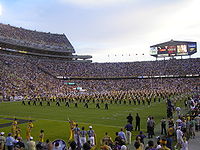
The LSU Tiger Marching Band performs in Tiger Stadium
LSU's official fight song is "Fight for LSU". During LSU football games, it is only played when the team runs onto the field, whenever a field goal or extra point is scored, and at the end of each half (though at the end of the first half a recording is played since the band is already on the sidelines and unable to perform it live). There are, however, multiple other songs that are synonymous with LSU. "Pregame Entrance/Touchdown for LSU" begins with those four powerful notes familiar to most college football fans. This song is played by the Louisiana State University Tiger Marching Band before the game begins, at the beginning of the fourth quarter, and any critical moment in the fourth quarter when Tiger Stadium needs to get even more "amped up."
Tiger Stadium
Although originally to be nicknamed "Deaf Valley" for its excruciating levels of sound, the nickname "Death Valley" caught on instead. It is legendary for the crowd noise generated by fans. It is the sixth largest college football stadium in the nation and third largest stadium in the SEC, holding 92,400 fans. The Tiger Stadium atmosphere is generally considered one of the loudest and most electrifying college football experiences in the country. During a nationally televised game against Auburn in 2003, ESPN recorded a noise level of 117 decibels at certain points in the game. In 2007 when the No. 1 ranked Tigers played the No. 9 ranked Florida Gators, the noise level registered at 122 decibels when the Tigers made a come-from-behind win in the final minutes of the game.
A similar sound level resulted in the legendary "Earthquake Game" against Auburn in 1988. LSU won 7-6 when quarterback Tommy Hodson completed a game-winning touchdown pass to running back Eddie Fuller in the waning seconds of the game. The crowd's roar registered on a seismograph, shaking the ground as much as a small earthquake.
Rivals
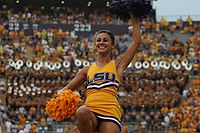
Louisiana State University cheerleader
Rivals include the traditional intrastate rival Tulane Green Wave, SEC West rivals Ole Miss Rebels, Mississippi State Bulldogs, Auburn Tigers, Alabama Crimson Tide, Arkansas Razorbacks and the SEC East rival Florida Gators (designated under the SEC's inter-division "designated rival" format). LSU and Arkansas play annually in football the Friday after Thanksgiving alternating sites between Baton Rouge and Little Rock. The winner of the game is awarded the "Golden Boot," a gold plated trophy that is formed in the shape of the two states. LSU and in-state rival Tulane battle for the "Tiger Rag", a flag divided evenly between the colors of the two schools.
The LSU-Auburn rivalry has become more important in recent years, but since the advent of the SEC's divisional format, the divisional winner has usually ended up being the West Division winner. The LSU-Florida rivalry also has major importance as the two schools have won three of the last four football national championships (Florida in 2006 and 2008; LSU in 2007).
[edit] Louisiana State University Lab School
Main article: Louisiana State University Laboratory School
The university operates the Louisiana State University Laboratory School, a Kindergarten through 12 public school. The School was established by the College of Education of Louisiana State University and has operated under its auspices for over eighty years. This coeducational school exists as an independent system to provide training opportunities for pre- and in-service teachers and to serve as a demonstration and educational research center. Since the school is part of the LSU system, students are required to pay tuition. The school is located on the main campus of Louisiana State University in Baton Rouge. LSU Laboratory School was the first International Baccalaureate Diploma Program school in the state of Louisiana and is adopting the complete K-12 program. IB is a model curriculum that stresses creativity, inquiry, service, and internationalism.
Notable alumni
Main article: List of Louisiana State University alumni
With strong academics and athletics programs, LSU has seen many of its former students go on to local and national prominence.
Several LSU athletes have gone on to recognition for their prominence in their respective sports. Pete Maravich played basketball for LSU and was three-time consensus first team All-American and 1970 National 'Player of the Year'. Shaquille O'Neal also played basketball for LSU and received many honors, including being named twice as a first team Men's Basketball All-American and twice as the SEC Player Of The Year. Billy Cannon played Halfback for LSU and is the only LSU player to win the Heisman Trophy (in 1959). Cannon was inducted into the College Football Hall of Fame in 2009. JaMarcus Russell, Oakland Raiders Quarterback number 1 draft pick of 2006.
LSU alumni have also been active on both the national and international stage in the fields of politics, academia, and the arts. Such notables include James Carville, who was the senior political adviser to Bill Clinton, and Donna Brazile, the campaign manager of the 2000 presidential campaign of Vice-President Al Gore. Hubert Humphrey, the 38th Vice President of the United States, earned a master's degree in political science before becoming the junior United States Senator from Minnesota. Randy Moffett, president of the University of Louisiana System (ULS) and formerly president of Southeastern Louisiana University received his Ed.D. from Louisiana State University in 1980. Academy Award-winning actress Joanne Woodward majored in drama during her enrollment at LSU.
America's early Space Program benefited from the services of two LSU Graduates. NASA Engineer Maxime Faget was a Naval Reserve Officer and the NASA Engineer responsible for the design of the Mercury Capsule, Apollo Command Module, Capsule Escape Tower System, Mach Meter, and the STS Space Shuttle Orbiter Vehicle and System (STS=Space Transportation System). NASA Pioneer/Founder Walter C. Williams established what is now known as NASA's Dryden Flight Research Center, previously known as Muroc Army Station. Dr. Williams was directly involved with the Bell X-1 program, "Glamorous Glennis", research flights which led to the first manned flight exceeding the speed of sound in level flight. Dr. Williams was on the Aeronautical Board of NACA, and was responsible for hiring many of the "pioneers" of what has now become America's Space Program, NASA.
Hubert Humphrey, 38th Vice President of the United States and United States Senator.
|
James Carville, former Presidential campaign adviser to Bill Clinton.
|
Will Wright, video game designer and creator of The Sims, the best-selling PC game of all time.
|
Shaquille O'Neal, four-time NBA Championship winner
|
Lieutenant General Claire Lee Chennault, military aviator who commanded the Flying Tigers during World War II.
|
更多
- Highland Road Park Observatory
- List of forestry universities and colleges
- Louisiana State University Athletic Hall of Fame
- Louisiana State University System
- LSU Hilltop Arboretum
- LSU Honors College
- Pete Maravich Assembly Center
参考文献
- ^ "The History of LSU". LSU Office of Communications & University Relations. January 28, 2009. http://www.lsu.edu/visitors/history.shtml. Retrieved October 10, 2009.
- ^ "LSU Flagship Agenda". Louisiana State University. 2006-01-01. http://www.lsu.edu/flagshipagenda/. Retrieved 2009-08-19.
- ^ http://www.nacubo.org/Documents/research/2009_NCSE_Public_Tables_Endowment_Market_Values.pdf
- ^ "Louisiana State University Quick Facts". Louisiana State University. July 9, 2009. http://www.lsu.edu/visitors/quickfacts.shtml. Retrieved 2009-08-19.
- ^ "Louisiana State University Enrollment". Louisiana State University. September 12, 2010. http://www.bgtplan.lsu.edu/.../preliminary/.../spring09_day14_status.pdf. Retrieved 2010-08-19.
- ^ "LSU Colors". LSU Office of Communications & University Relations. September 23, 2009. http://www.lsu.edu/pa/identity/colors.html. Retrieved October 10, 2009.
- ^ "Louisiana State University". Louisiana State University. October 3, 2009. http://www.lsu.edu/. Retrieved October 12, 2009.
- ^ "Louisiana Colleges and Universities". Education Portal Online. September 18, 2009. http://education-portal.com/articles/Louisiana_%28LA%29:_University_and_College_Educational_System.html. Retrieved September 30, 2090.
- ^ "A Welcome from the Vice Chancellor". LSU Office of Research & Economic Development. August 27, 2009. http://www.lsu.edu/research/welcome.shtml. Retrieved September 12, 2009.
- ^ Higgns, John. "Louisiana State University". Encyclopedia Britannica. http://www.britannica.com/EBchecked/topic/349317/Louisiana-State-University. Retrieved October 3, 2009.
- ^ Bergeron, Arthur (1996). Guide to Louisiana Confederate Military Units, 1861-1865. LSU Press. ISBN 0807121029.
- ^ Ruffin, Thomas; Jackson, Jo; Hebert, Mary (2002). Under Stately Oaks: A Pictorial History of LSU. Baton Rouge: Louisiana State University Press. pp. 3–7. ISBN 0807126829.
- ^ "Quick Facts: Academics and Research". Louisiana State University. July 9, 2009. http://www.lsu.edu/visitors/quickfacts.shtml. Retrieved 2009-08-19.
- ^ Flemming, Walter (1936). Louisiana State University, 1860-1896. Louisiana State University Press. pp. 170–184.
- ^ "Louisiana State University". Huey Long Legacy Project. 2009. http://www.hueylong.com/programs/louisiana-state-university.php. Retrieved 2009-08-19.
- ^ Hebert, Mary (1995). "Remembering the Scandels". Oral History Newsletter 3 (2). http://www.lib.lsu.edu/special/williams/newsletters/ohnewsletter7.html.
- ^ Thomas, Charles (March 8, 1999). "African Americans in Baton Rouge". Louisiana State University. http://www.lib.lsu.edu/special/exhibits/redstick/index.html. Retrieved October 10, 2009.
- ^ "About LSU Honors College". Louisiana State University. October 16, 2009. http://www.honors.lsu.edu/. Retrieved October 11, 2009.
- ^ "Classes resume at LSU after Katrina". CNN News. September 7, 2005. http://www.cnn.com/2005/US/09/07/katrina.lsu/index.html. Retrieved 2009-08-19.
- ^ "Meet Michael Martin". Louisiana State University. 2009. http://www.lsu.edu/highlights/2008/08/martin.html. Retrieved 2009-08-19.
- ^ Stevens, Craig (October 9, 2009). "About CAMD". LSU Center for Advanced Microstructures & Devices. http://www.camd.lsu.edu/aboutcamd.htm. Retrieved October 11, 2009.
- ^ "The LSU Campus". Louisiana State University. January, 2004. http://www.lsu.edu/highlights/041/beauty.html. Retrieved 2009-08-19.
- ^ "Overview of the Campus Environment". LSU Office of Facility Services. October 12, 2009. http://www.lsu.com/facility/facility.nsf/$Content/Overview+of+Campus+Environment?OpenDocument. Retrieved September 4, 2009.
- ^ "LSU News & Publication". Louisiana State University. April 19, 2009. http://www.law.lsu.edu/index.cfm?geaux=newsandpublications.fastfacts. Retrieved 2009-08-19.
- ^ fonti, Laura (November 11, 2004). "LSU Researchers Protect Secrets Of LSU’s Indian Mounds". Louisiana State University. http://www.lsu.edu/highlights/032/mounds.html. Retrieved August 14, 2009.
- ^ "LSU Academics". Louisiana State University. October 10, 2009. http://www.lsu.edu/students/academics.shtml. Retrieved October 11, 2009.
- ^ Shanghai Jiao Tong University (2009). "Academic Ranking of World Universities". Institute of Higher Education, Shanghai Jiao Tong University. http://www.arwu.org/ARWU2009.jsp. Retrieved 2009-12-23.
- ^ Shanghai Jiao Tong University (2009). "Ranking of North & Latin American Universities". Institute of Higher Education, Shanghai Jiao Tong University. http://www.arwu.org/Americas2009.jsp. Retrieved 2009-12-23.
- ^ "America's Best Colleges". Forbes. 2009. http://www.forbes.com/lists/2009/94/colleges-09_Americas-Best-Colleges_Rank.html. Retrieved 2009-09-13.
- ^ The Times (2009). "World University Rankings". The Times Higher Educational Supplement. http://www.topuniversities.com/university-rankings/world-university-rankings/2009/results. Retrieved 2010-02-09.
- ^ "National Universities Rankings". America's Best Colleges 2009. U.S. News & World Report. 2009. http://colleges.usnews.rankingsandreviews.com/college/national-search. Retrieved 2009-05-18.
- ^ Presnall, Leslie (February 13, 2009). "University among most popular colleges". The Daily Reveille (Baton Rouge). http://www.lsureveille.com/university-among-most-popular-colleges-1.1374928. Retrieved October 11, 2009.
- ^ Luedtke, Wendy (March 28, 2008). "U.S. News Ranks E. J. Ourso College's Professional Programs In Top 40". LSU E. J. Ourso College of Business. http://www.bus.lsu.edu/students/news/stories/2008.03.28_us_news_top40.asp. Retrieved November 18, 2009.
- ^ "Center for Internal Auditing CIA Certification". LSU Center for Internal Auditing. April 15, 2009. http://www.bus.lsu.edu/centers/cia/certification.asp. Retrieved September 23, 2009.
- ^ Forever LSU
- ^ LSU Media Relations (August 20, 2009). "Faculty & Staff Focus, General Information, Honors & Awards, Media Advisory". Press release. http://appl003.lsu.edu/unv002.nsf/9faf000d8eb58d4986256abe00720a51/3ad29efd1bc73f128625761800704bee?OpenDocument. Retrieved September 22, 2009.
- ^ "U.S. News and World Report's Best Law Schools: 2009 Edition". U.S. News and World Report. Kerry F. Dyer. September 23, 2009. http://grad-schools.usnews.rankingsandreviews.com/best-graduate-schools/top-law-schools/rankings. Retrieved September 23, 2009.
- ^ Anderson, Rob (August 20, 2009). "LSU program ranked as one of the best in the country by Entrepreneur magazine". LSU Office of University Relations. http://www.lsu.edu/highlights/033/lbtc.html. Retrieved October 1, 2009.
- ^ Presnall, Leslie (January 20, 2008). "School of Landscape Architecture ranked No. 2". The Daily Reveille (Baton Rouge). http://www.lsureveille.com/2.4051/school-of-landscape-architecture-ranked-no-2-1.918639. Retrieved October 11, 2009.
- ^ "U.S. News and World Report's Best Education Schools: 2009 Edition". U.S. News and World Report. Kerry F. Dyer. September 23, 2009. http://grad-schools.usnews.rankingsandreviews.com/best-graduate-schools/top-education-schools/rankings. Retrieved September 23, 2009.
- ^ "Department of French Program Overview". LSU Department of French Studies. September 16, 2006. http://appl003.lsu.edu/artsci/frenchweb.nsf/$Content/About+Us?OpenDocument. Retrieved September 18, 2009.
- ^ Goldsmith, Sarah (April 4, 1999). "LSU French program earns international accolades, high national rankings". LSU News Service (Baton Rouge: LSU Office of Public Affairs). http://www.lsu.com/UNV002.nsf/%28NoteID%29/1038753E74A702D0862568E0004E915B?OpenDocument. Retrieved September 12, 2009.
- ^ "U.S. News and World Report's Fine Arts Rankings: 2008 Edition". U.S. News and World Report. Kerry F. Dyer. September 16, 2008. http://grad-schools.usnews.rankingsandreviews.com/best-graduate-schools/top-fine-arts-schools/rankings/page+4. Retrieved September 23, 2009.
- ^ "U.S. News and World Report's Library and Information Studies: 2009 Edition". U.S. News and World Report. Kerry F. Dyer. 22 April 2009. http://grad-schools.usnews.rankingsandreviews.com/best-graduate-schools/top-library-information-science-programs/rankings. Retrieved 20 January 2010.
- ^ LSU Office of Public Affairs (August 1, 2006). "LSU Libraries". Press release. http://www.foreverlsu.org/priorities/PDFs/lib.pdf. Retrieved September 15, 2009.
- ^ "LSU: About the Libraries". Louisiana State University. 2000. http://www.lib.lsu.edu/lib/about.html. Retrieved 2009-08-20.
- ^ "LSU Museums". Louisiana State University. April 4, 2002. http://www.lsu.edu/highlights/022/tower.htm. Retrieved October 11, 2009.
- ^ LSU Office of Public Affairs (August 1, 2006). [www.foreverlsu.org/priorities/PDFs/moa.pdf "LSU Libraries"]. Press release. www.foreverlsu.org/priorities/PDFs/moa.pdf. Retrieved September 15, 2009.
- ^ "LSU MOA: About". Louisiana State University. 2000. http://www.lsumoa.com/content.php?display=about. Retrieved 2009-09-10.
- ^ "LSU Museum of Natural Science". Louisiana State University. 2000. http://www.museum.lsu.edu/MNS/index.html. Retrieved 2009-09-10.
- ^ "LSU Museum Of Rural Life: About About". Louisiana State University. 2000. http://www.lsu.edu/highlights/022/rural.htm. Retrieved 2009-09-10.
- ^ "LSU Museum of Natural History: Information". Louisiana State University. 2000. http://appl003.lsu.edu/natsci/lmnh.nsf/$Content/History?OpenDocument. Retrieved 2009-09-10.
- ^ "Campus Life at LSU". Louisiana State University. 2009. http://appl003.lsu.edu/slas/csli.nsf/$Content/Campus+Life+Description?OpenDocument. Retrieved 2009-09-10.
- ^ "LSU Student Government". Louisiana State University. 2009. http://www.sg.lsu.edu/. Retrieved 2009-09-12.
- ^ "EPy Award Winners: 2008". Editor and Publisher Magazine. March 16, 2008. http://royal.reliaserve.com/eppy/winners2008.html. Retrieved September 21, 2009.
- ^ "LSU Office of Student Media". Louisiana State University. 2009. http://www.lsu.edu/studentmedia/klsu.html. Retrieved 2009-09-10.
- ^ "Greek Life". Louisiana State University. 2009. http://appl003.lsu.edu/slas/greekaffairs2.nsf/index. Retrieved 2009-09-10.
- ^ "LSU Interfraternity Council - Fraternities". http://appl003.lsu.edu/slas/GreekAffairs2.nsf/$Content/Greek+Orgainzations+at+LSU?OpenDocument. Retrieved 2009-09-10.
- ^ "LSU National Pan-Hellenic Council". http://appl003.lsu.edu/slas/GreekAffairs2.nsf/$Content/Greek+Orgainzations+at+LSU?OpenDocument. Retrieved 2009-09-10.
- ^ "LSU Pan-Hellenic Council". http://appl003.lsu.edu/slas/GreekAffairs2.nsf/$Content/Greek+Orgainzations+at+LSU?OpenDocument. Retrieved 2009-09-10.
- ^ Barrow, Bill (January 17, 2008). "LSU Chancellor O'Keefe resigns". The Times-Picayune (New Orleans). http://www.nola.com/news/t-p/capital/index.ssf?/base/news-5/1200551432230120.xml&coll=1. Retrieved February 8, 2009.
- ^ Martin, Mike (August 19, 2009). "Latest Budget Information". LSU Office of the Chancellor. http://www.lsu.edu/chancellor/budget/updates.htm. Retrieved September 19, 2009.
- ^ "LSU National Flagship Action Agenda: 2003-2010". Louisiana State University. March 28, 2002. http://appl003.lsu.edu/acadaff/flagship.nsf/$Content/Action+Plans+&+Outcomes?OpenDocument. Retrieved October 1, 2009.
- ^ "LSU Press: About Us". Louisiana State University Press. April 13, 2008. http://www.lsu.edu/lsupress/about.html. Retrieved October 11, 2009.
- ^ Brooks, Cleanth (1953). An Anthology of Stories from the Southern Review. Baton Rouge: Louisiana State University Press. http://www.lsu.edu/thesouthernreview/history.html.
- ^ LSU Media Relations (May 24, 2006). "LSU’s Legacy wins top national award from the Society of Professional Journalists". Press release. http://www.lsu.com/unv002.nsf/%28NoteID%29/4E1BA07E67420B8F862571780072C200?OpenDocument. Retrieved October 10, 2009.
- ^ "The New Delta Review: About Us". The New Delta Review (Baton Rouge: LSU Department of English). 2007. http://www.english.lsu.edu/artsci/englishweb.nsf/$Content/Journals/$file/aboutus.htm. Retrieved October 10, 2009.
- ^ "Southeastern Conference". The Southeastern Conference. 2009. http://www.secsports.com/schools/. Retrieved October 10, 2009.
- ^ Amis, Rod (October 11, 2005). Katrina and the lost city of New Orleans. Lulu. pp. 77. ISBN 1411663667. http://books.google.com/books?id=QGeuNDl3oYgC&dq=LSU+colors&lr=&client=firefox-a&source=gbs_navlinks_s.
- ^ Lockwood, C. C. (September, 2003). Mike the Tiger: The Roar of LSU. Louisiana State University Press. pp. 2–4. ISBN 0807128880. http://books.google.com/books?id=cJJQFyDsm4sC&pg=PA114&dq=LSU+tigers&client=firefox-a#v=onepage&q=LSU%20tigers&f=false.
- ^ Greatest Moments in LSU Football History. Baton Rouge: The Baton Rouge Advocate. September 24, 2002. pp. 143–197. ISBN 1582615101. http://books.google.com/books?id=-43SPTBE2hwC&pg=PA143&dq=LSU+football&client=firefox-a#v=onepage&q=&f=false.
- ^ Mule, Marty (August 1, 2006). Game of My Life: LSU Memorable Moments of Tigers Football. Sports Publishing. pp. 156–216. ISBN 159670005X. http://books.google.com/books?id=d59SfPQzCmYC&pg=PA203&dq=LSU+colors&lr=&client=firefox-a#v=onepage&q=LSU%20colors&f=false.
- ^ Lockwood, C. C. (September, 2003). Mike the Tiger: The Roar of LSU. Louisiana State University Press. pp. 11–14. ISBN 0807128880. http://books.google.com/books?id=cJJQFyDsm4sC&pg=PA114&dq=LSU+tigers&client=firefox-a#v=onepage&q=LSU%20tigers&f=false.
- ^ "Alex Box Stadium at LSU". LSU Athletic Department and Tiger Athletic Foundation. December, 2008. http://www.newalexbox.net/. Retrieved September 1, 2009.
- ^ "Tiger Stadium (92,400)". www.LSUsports.net. October 12, 2009. http://www.lsusports.net/ViewArticle.dbml?DB_OEM_ID=5200&ATCLID=177159. Retrieved October 12, 2009.
- ^ Wickes, Frank (2008). "The Marching Tigers". LSU Department of Bands. http://www.bands.lsu.edu/band_history/index.php. Retrieved Septermber 12, 2009.
- ^ Cologne, Kristine (August, 2003). "After 15 Years, LSU-Auburn Game Still An Earthshaking Experience". LSU Office of University Relations. http://www.lsu.edu/highlights/033/football.html. Retrieved July 24, 2007.
- ^ Mezydlo, Jeff (October 7, 2008). "LSU-Florida Preview". The Times-Picayune. http://stats.nola.com/cfb/preview.asp?g=200810110067&e=2008_07_0067&home=67&vis=76. Retrieved October 2, 2009.
- ^ Jones, David (October 8, 2009). "Florida Gators opponent preview: LSU Tigers". Orlando Examiner (Orlando, Florida). http://www.examiner.com/x-12915-Orlando-Sports-Examiner~y2009m10d8-Florida-Gators-opponent-preview-LSU-Tigers. Retrieved October 10, 2009.
- ^ "Louisiana State University Laboratory School: About Us". LSU Lab School. http://www.uhigh.lsu.edu/about_us/facts.htm. Retrieved 2009-09-09.
- ^ "LSU Athletics Hall of Fame Members". www.LSUsports.net. October 29, 2008. http://www.lsusports.net/ViewArticle.dbml?DB_OEM_ID=5200&ATCLID=177326. Retrieved October 12, 2009.
- ^ LSU Office of Public Affairs (June, 2006). "Points of Pride: LSU Notable Alumni". Press release. http://www.foreverlsu.org/updates/PDFs/06373PointsofPride.pdf. Retrieved October 10, 2009.
- ^ "Notable LSU Graduates". LSU Office of Communications & University Relations. February, 2008. http://www.lsu.edu/pa/facts/alumni.shtml. Retrieved October 10, 2009.
- ^ Curry, Marty (February 6, 2002). "Walter C. Williams". National Aeronautics and Space Administration. http://www.dfrc.nasa.gov/Gallery/Photo/Directors/HTML/E49-0170.html. Retrieved October 10, 2009.
External links
 |
Wikimedia Commons has media related to: Louisiana State University |
- Official website
- Official athletics website



